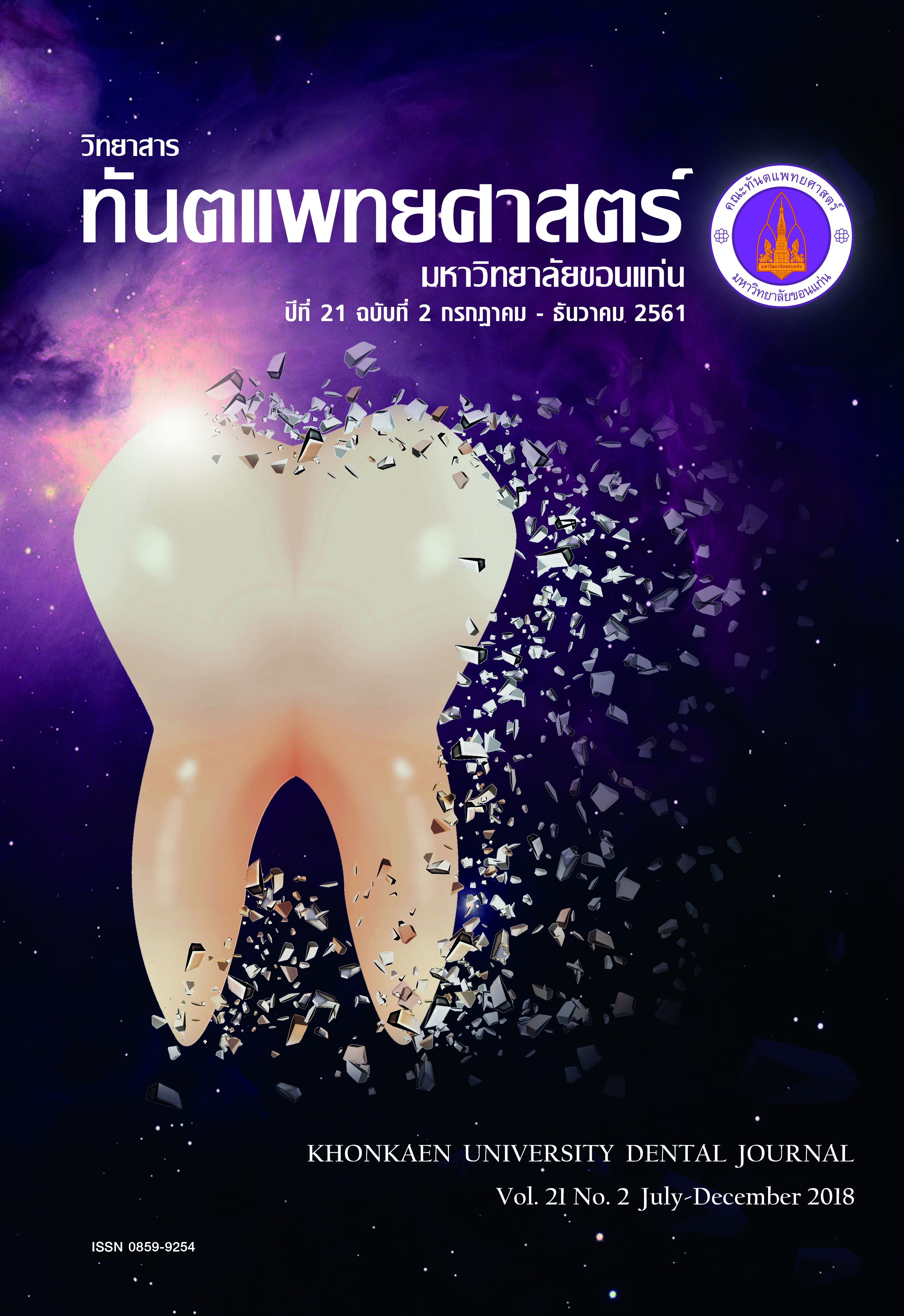Wound Healing between Thai Propolis Product and Calcium Hydroxide in Direct Pulp Capping using a Whole Tooth Culture Model: Preliminary Study
Main Article Content
Abstract
The aim of this study was to compare the wound healing between Thai propolis product and calcium hydroxide in direct pulp capping using a whole human tooth culture model in vitro. Thirteen extracted human third molars were divided into two control groups and two experimental groups. The negative control group (n=3) consisted of one tooth that was neither mechanically exposed nor cultured, teeth that were not mechanically exposed and cultured for 7 days (n=1) and 14 days (n=1). The positive control group (n=2) consisted of teeth that were mechanically exposed without capping material and cultured for 7 days (n=1) and 14 days (n=1). The experimental calcium hydroxide group consisted of teeth that were mechanically exposed, direct pulp capped with calcium hydroxide and cultured for 7 days (n=2) and 14 days (n=2). The experimental Thai propolis product group consisted of teeth that were mechanically exposed, direct pulp capped with Thai propolis product and cultured for 7 days (n=2) and 14 days (n=2). The histological study demonstrated a chronic inflammation in all groups except no inflammation in the negative control group in which the immediately extracted tooth was not cultured. Teeth in the positive control group that were mechanically exposed without capping material and cultured for 7 days showed the highest level of inflammation. The inflammation levels of calcium hydroxide group and Thai propolis product group were not different. Teeth capped with Thai propolis product and cultured for 7 days demonstrated an intact odontoblastic layer attached to the dentin whereas teeth capped with calcium hydroxide showed the detachment of odontoblastic layer from the dentin.
Article Details
บทความ ข้อมูล เนื้อหา รูปภาพ ฯลฯ ที่ได้รับการลงตีพิมพ์ในวิทยาสารทันตแพทยศาสตร์ มหาวิทยาลัยขอนแก่นถือเป็นลิขสิทธิ์เฉพาะของคณะทันตแพทยศาสตร์ มหาวิทยาลัยขอนแก่น หากบุคคลหรือหน่วยงานใดต้องการนำทั้งหมดหรือส่วนหนึ่งส่วนใดไปเผยแพร่ต่อหรือเพื่อกระทำการใด ๆ จะต้องได้รับอนุญาตเป็นลายลักษณ์อักษร จากคณะทันตแพทยศาสตร์ มหาวิทยาลัยขอนแก่นก่อนเท่านั้น
References
2. Kidd EA. Microleakage: a review. J Dent 1976;4:199-206.
3. Witherspoon DE. Vital pulp therapy with new materials: new directions and treatment perspectives--permanent teeth. J Endod 2008;34:S25-8.
4. Parirokh M, Torabinejad M. Mineral trioxide aggregate: a comprehensive literature review--Part III: Clinical applications, drawbacks, and mechanism of action. J Endod 2010;36:400-13.
5. Siripatarawan U, Vitchayakitti W, Sanguandeekul R. Antioxidant and antimicrobial properties of Thai propolis extracted using ethanotl aqueous solution. Int J Food Sci Tech 2013;48:24-7.
6. Banskota AH, Tezuka Y, Kadota S. Recent progress in pharmacological research of propolis. Phytother Res 2001;15:561-71.
7. Sforcin JM, Bankova V. Propolis: is there a potential for the development of new drugs? J Ethnopharmcol 2010; 133:253-60.
8. Parolia A, Thomas M, Kundabala M, Mohan M. propolis and its potential uses in oral health. Int J Med Med Sci 2010;2:210-5.
9. Wieckiewicz W, Miernik M, Wieckiewicz M, Morawiec T. Does propolis help to maintain oral health? Evid Based Complement Alternat Med 2013;2013:351062.
10. Phankhongsap A, Chailertvanitkul P, Juntavee A, Peerapattana J, Puasiri S. Effectiveness of root canal irrigant from mangosteen pericarp extracts with papain and propolis extracts with papain on mixture of Streptococcus gordonii and Enterococcus faecalis. J dent Assoc Thai 2014;64: 234-42.
11. Pengchum S, Chailertvanitkul P, Laopaiboon M, Thaweesit P, Abbott PV, Krisanaprakornkit S. Thai propolis extract as root canal medication against Enterococcus faecalis infection. Khon Kaen Dent J 2018;21:30-8.
12. Prueksakorn A, Puasiri S, Ruangsri S, Makeudom A, Sastraruji T, Krisanaprakornkit S, Chailertvanitkul P. The preservative effect of Thai propolis extract on the viability of human periodontal ligament cells. Dent Traumatol 2016;32:495-501.
13. Sabir A, Tabbu CR, Agustiono P, Sosroseno W. Histological analysis of rat dental pulp tissue capped with propolis. J Oral Sci 2005;47:135-8.
14. Parolia A, Kundabala M, Rao NN, Acharya SR, Agrawal P, Mohan M, et al. A comparative histological analysis of human pulp following direct pulp capping with Propolis, mineral trioxide aggregate and Dycal. Aust Dent J 2010;55:59-64.
15. Tecles O, Laurent P, Zygouritsas S, Burger AS, Camps J, Dejou J, et al. Activation of human dental pulp progenitor/ stem cells in response to odontoblast injury. Arch Oral Biol 2005;50:103-8.
16. Tecles O, Laurent P, Aubut V, About I. Human tooth culture: a study model for reparative dentinogenesis and direct pulp capping materials biocompatibility. J Biomed Mater Res B Appl Biomater 2008;85:180-7.
17. Chailertvanitkul P, Namsirikul T, Damrongrungruang T, Peerapattana J. Phenolic and flavonoids contents and antibacterial activity of ethanolic extract of propolis. Int J Pharm Sci 2017;13:59-67.
18. Aeinehchi M, Eslami B, Ghanbariha M, Saffar AS. Mineral trioxide aggregate (MTA) and calcium hydroxide as pulp-capping agents in human teeth: a preliminary report. Int Endod J 2003;36:225-31.
19. Asgary S, Eghbal MJ, Parirokh M, Ghanavati F, Rahimi H. A comparative study of histologic response to different pulp capping materials and a novel endodontic cement. Oral Surg Oral Med Oral Pathol Oral Radiol Endod 2008;106:609-14.
20. Magloire H, Joffre A, Bleicher F. An in vitro model of human dental pulp repair. J Dent Res 1996; 5:1971-8.
21. Aguilar P, Linsuwanont P. Vital pulp therapy in vital permanent teeth with cariously exposed pulp: a systematic review. J Endod 2011;37:581-7.
22. Olsson H, Petersson K, Rohlin M. Formation of a hard tissue barrier after pulp cappings in humans. A systematic review. Int Endod J 2006;39:429-42.


